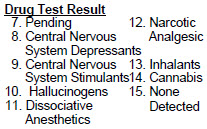Operators, Occupants, Pedestrians, Cyclists-Excluding Witnesses
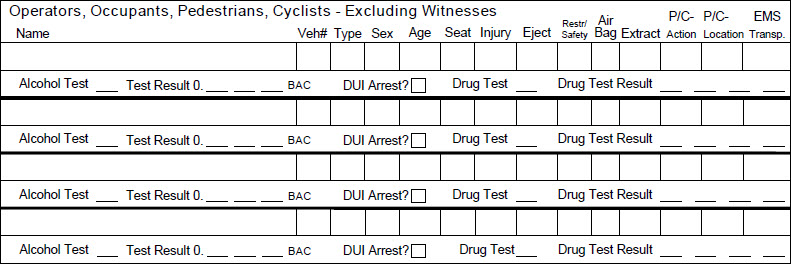
Note to Web Crash users: In the web application, some Operator information in the above table is automatically populated from page 1. The remaining Occupants of a vehicle and Pedestrians and Cyclists will be entered on a separate page/table from the Operators.
94. Name - Enter the complete name of the occupant (operator or passenger) of the vehicle or the involved person. (In the web application, the Operator name(s) will automatically populate from page 1 information.)
95. Vehicle Number - Enter the vehicle number in which the person named above was seated. If a pedestrian or bicyclist was injured leave this box blank. (In the web application, the Vehicle Number for Operators will automatically populate from page 1 information.)
96. Type - Enter the type of the person’s involvement based upon the codes type found at the bottom of Page 3. Number 2 refers to any occupant in the vehicle other than the operator. (In the web application, the person Type for Operators will automatically populate from page 1 information.)
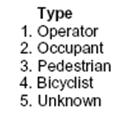
97. Sex - Enter “M” for male, “F” for female or “U” if unknown. (In the web application, the Sex information for the vehicle Operators will automatically populate from page 1 information.)
98. Age - Enter the age of the involved person in terms of years. Persons less than one year old should be entered as “x.x". Example: a child that is 6 months old is entered as 0.5. A child that is 7 months old is entered as 0.6. (7 / 12 = 0.6.)
(In Web Crash, the person Age for Operators will automatically populate from page 1 information. Also, if age is unknown for other occupants, pedestrians, or cyclists, code as 999.)
99. Seat - For each involved person, enter the number which best describes his/her seat position. Seat positions 1-6 represent the typical seating arrangement found in a passenger car. Positions 7-9 depict a third row of seats, i.e., mini-vans, station wagons, etc. Ten is a miscellaneous category for passengers riding in such areas as a sleeper section of a cab, other enclosed passenger or cargo area (example: rear cargo area commonly found in utility vehicles, mini-vans and station wagons), unenclosed passenger or cargo area (example: bed of a pickup truck) or in a bus.
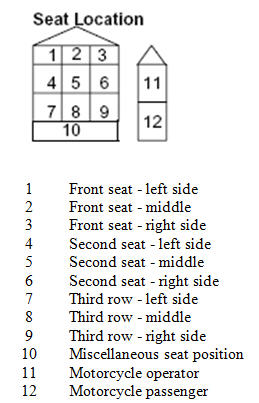
100. Injury - The classification of injuries provides a category for any person involved in a motor vehicle crash. There are seven categories of injury to persons used for classification:
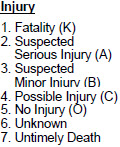
Enter the code that best describes the involved person’s injury level based upon the following definitions.
1. Fatality (K) is any injury that results in death within 30 days after the motor vehicle crash in which the injury occurred.
PLEASE NOTE: The National Highway Traffic and Safety Administration’s (NHTSA) definition under the Fatal Analysis Reporting System (FARS) requirement, a “fatal injury must only be used if the death occurred within thirty consecutive 24-hour time periods from the time of the crash”. If a death happens after the 30 day period, code as Injury Crash type and the injury is coded as Suspected Serious Injury (A).
2. Suspected Serious Injury (A) is any injury other than fatal, which results in one or more of the following:
- Severe laceration resulting in exposure of underlying tissues/muscle/organs or resulting in significant loss of blood
- Broken or distorted extremity (arm or leg)
- Crush injuries
- Suspected skull, chest or abdominal injury other than bruises or minor lacerations
- Significant burns (second and third degree burns over 10% or more of the body)
- Unconsciousness when taken from the crash scene
- Paralysis
Excludes: Momentary unconsciousness.
General: Determinations are made on the basis of the best information available. It is not necessary to consult with doctors or hospitals unless information is not otherwise available, apparent condition immediately after the crash does not govern classification because the person may recover from hysteria quickly or may begin to feel the effects of internal or other injuries between the time of the crash and the time of leaving the scene.
3. Suspected Minor Injury (B) is any injury that is evident at the scene of the crash, other than fatal or serious injuries. Examples include lump on the head, abrasions, bruises, minor lacerations (cuts on the skin surface with minimal bleeding and no exposure of deeper tissue/muscle).
Excludes: Limping (the injury cannot be seen).
Examples: Pedestrian is unconscious on the ground after the crash; his clothes are torn and blood oozes from abrasions. When the ambulance arrives, he is conscious, able to give information and walk around. He goes to the hospital in the ambulance, but is able to sit up and there is no evidence that he is incapacitated.
4. Possible Injury (C) is any injury reported or claimed which is not a fatal, incapacitating, or non-incapacitating evident injury.
Includes: Momentary unconsciousness. Claim of injuries not evident. Limping, complaint of pain, nausea, hysteria.
General: Possible injuries are those which are claimed or reported, or indicated by behavior, but not by wounds.
Example: Occupant complains of pain, but shows no sign of bleeding or wounds; leaves the scene of the motor vehicle traffic crash in a taxi to keep an appointment, and dies. This is a possible injury when classified at the time of leaving the scene.
5. No Injury (O) is a situation in where there is no reason to believe that the person received any bodily harm from the motor vehicle traffic crash in which involved.
Includes: Confusion, excitement, anger. Internal injuries unknown to the injured until after leaving the crash scene.
6. Unknown is when information is not available at the time of the written report.
7. Untimely Death: A death occurring due to causes or injuries unrelated to the crash.
Example: A driver experiences a fatal heart attack prior to running off the road and hitting a tree. If the medical examiner determines that the heart attack killed the operator, then the death is considered untimely. The crash type will be considered an Injury crash.
101. Ejected - Use the following codes for whether the operator or passenger was ejected from the vehicle. The term ejected refers to a vehicle occupant being completely or partially thrown from a motor vehicle as a result of a crash.

102. Air Bag Deployed - If the vehicle is equipped with airbags, enter whether or not any airbags were deployed, entering 1 for “yes”, 2 for “no”, or 3 for “unknown”. If there are no airbags in the vehicle, then identify as “unknown”.
103. Extracted – Enter 1 for “yes, or 2 for “no” if extraction equipment was utilized.
104. Restraint/Safety Equipment - Restraint/Safety Equipment information must be provided for all individuals at the time of the crash. Enter the code number which best describes the type of restraint/safety equipment in use by each person when the crash happened. If a bicyclist is involved in the crash, indicate whether the bicyclist was wearing a helmet. If no helmet was used, code “No Helmet”. If multiple restraint/safety equipment items are being used, code belts or helmets first.
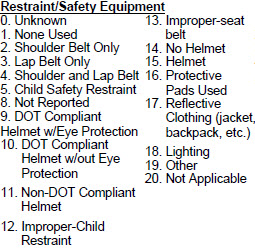
105. P/C-Act (Pedestrian/Cycle Action Codes) - Enter the code that best describes what the pedestrian or cyclist was doing at the time of the crash. This table can be found on overlay 1 of the paper report form pad.

106. P/C Loc (Pedestrian/Cycle Location Codes) - Enter the code which best describes where the pedestrian or cyclist was located at the time of the crash. Codes are found at the bottom of Overlay 1.

107. EMS Transp – Enter wither the occupant was transported for medical reasons by EMS.

108. Alcohol Test - In the box provided for Vehicles 1 and 2 enter the code for information on the alcohol test that is given. If multiple test are given (PBT, FSE, evidentiary) enter the code for the evidentiary test and the results. If evidentiary results are pending, enter the PBT code and results. If only an evidentiary test has been conducted and results are pending (blood), enter “999” in the test result field. This indicates that a test result is pending. Check whether the operator was arrested for DUI as well. (NOTE: This field indicates a test was given, not whether law enforcement requested the test. Autopsy test results should also be listed here.)
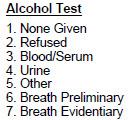

109. Blood Alcohol Concentration (BAC) is the percentage of alcohol in a person’s blood. Record the test result (Blood Alcohol Concentration) in the boxes provided if a test was given. Enter BAC data using the format of the examples below:
Vehicle 1
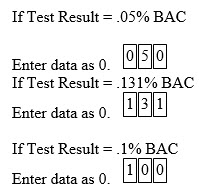
If the percent concentration is unknown leave blank. (For Web Crash, if the percent concentration is unknown, code as “999”. This field cannot be left blank in the web application.)
Repeat the above steps if a second vehicle were involved using the space provided. If three or more vehicles were involved, utilize additional report forms. Be sure to assign appropriate vehicle numbers. (If submitting electronically, additional pages can be added by using the option in the navigation area on the left side of the screen.)
110. Drug Test - In the box provided for Vehicle 1 enter the code for information on the type of drug test given. Do the same for Vehicle 2.

111. Drug Test Result - In the boxes provided for Vehicle 1, enter the codes for the test result. Note that the officer may enter up to four drug test results for each operator. Do the same for Vehicle 2.
